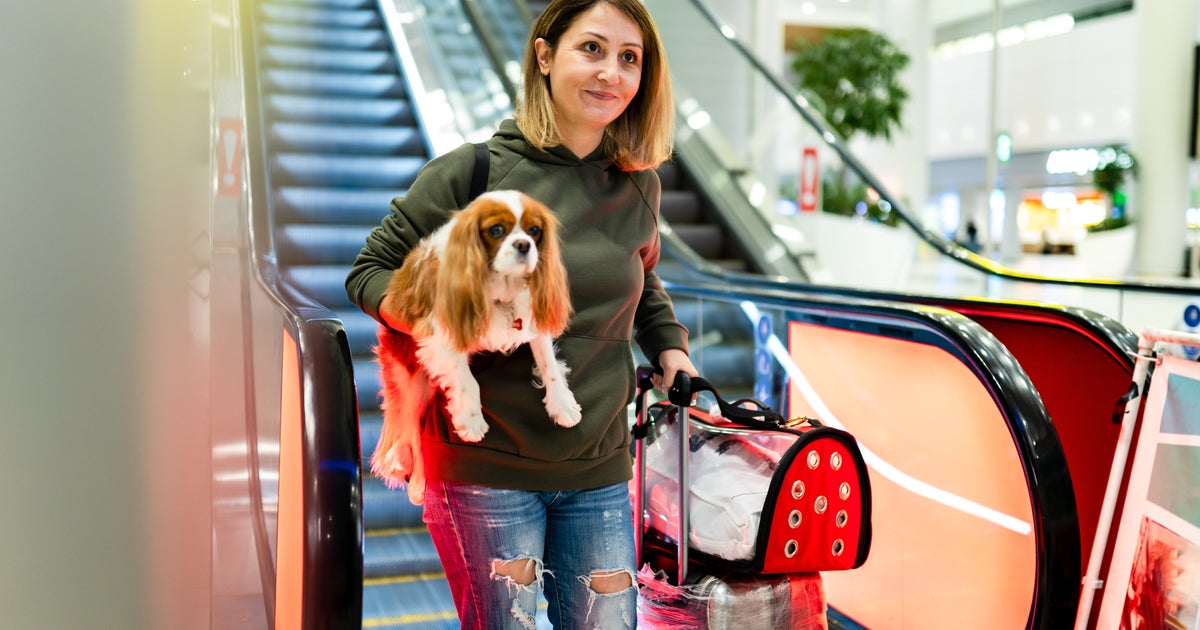9 Mistakes People Make When Traveling With Pets

Going on a vacation is a great way to take a break from the stresses of everyday life and recharge while exploring a new place. For pet owners, however, travel can present a different sort of challenge.
“We’ve all seen people on vacation watching videos of their pets at boarding or with family members,” Dr. Danielle Bernal, the global veterinarian at Wellness Pet Company, told HuffPost. “Today, our pets are very much part of the family. Choosing a pet-friendly destination is a great way of spending more time with the ones we love.”
In addition to removing the sadness of missing your pet, taking them with you on vacation can lead to discovering places you might not have otherwise visited, like a gorgeous local hiking trail or dog beach.
“Bringing our pets with us on vacation is a great way of meeting new people, having a fun topic of conversation and maximizing social interactions, which can help minimize loneliness and support our mental health,” Bernal said. “Bringing your pet with you is also a wonderful reason to get outside, get some fresh air and stay active, which is proven to improve your mood, sleep and mental health.”
But traveling with your pet is hardly guaranteed to be a smooth experience, particularly if you make certain ill-informed decisions. To help keep issues at bay, HuffPost asked pet experts to share the most common mistakes people make when they take their furry companions on a trip with them ― and some advice for avoiding these missteps.
Not Planning Ahead
“One of the biggest mistakes is not planning the trip with your pet in mind,” said Erin Askeland, an animal health and behavior consultant at Camp Bow Wow. “This includes failing to research pet-friendly accommodations, not checking airline or transportation regulations, and not considering the specific needs of your pet during travel and any situation that may arise.”
Make sure to familiarize yourself with the relevant travel regulations for pets, including airline and train policies and requirements for crossing state or international borders. Also, pay special attention to the rules around vaccinations, quarantines, health certificates and extra fees.
“Import requirements for other states and countries vary and often require research and time to get the pet ready to meet those requirements,” said Dr. Jessica Bell, an associate professor with the veterinary teaching hospital at Washington State University. “Hawaii requires rabies vaccines, rabies titer tests, the application of a parasite preventative and a waiting period prior to entry. The owner is also required to submit paperwork to Hawaii ahead of travel.”
If you’re flying, try to choose an airline with good policies and reviews around its handling of pets. If you’re driving, look up pet-friendly rest stops along the way. Regardless of how you travel, make sure to find the right accommodations for your family and ensure you’ll be in a good area to meet your animal’s needs when you reach your destination.
“There are more locations welcoming four-legged family members, but skipping the research and assuming your pup will be able to go everywhere can backfire,” Bernal said. “Prior to departing, determine where the local dog parks or beaches are for your dog to play. Understand if the local shops and restaurants will allow pets inside.”
Going Without Talking To Your Vet First
“The number one mistake I see is people not talking to their veterinarians about travel,” said Dr. Grant Little, a veterinarian expert with JustAnswer. “Talk to your veterinarian about what paperwork you need done and any vaccines or tests, and be prepared that it might not work out. Have a plan B if that means your pet will stay with someone else, at a boarding facility or some other type of care.”
In addition to ensuring your pet is up to date on vaccinations, you’ll want to schedule a veterinarian visit to discuss whether they’re healthy enough to travel and obtain any necessary medications or copies of their health records.
“Traveling can expose pets to new environments, pathogens or stresses that may affect their health,” Askeland said. “Neglecting their health needs or not carrying essential medications or supplies is a common mistake.”
Pack extra medicine in case you’re delayed getting home, and put any important health-related items in your carry-on luggage if you’re flying.
“Some dogs or cats get really nervous at the airport, being around large groups of people or being confined for long periods of time,” Little said. “It’s important to know your pet’s demeanor, and if this is an issue, your pet may benefit from sedative medications, calming sprays or pheromone products.”
Consider packing a pet first aid kit and identifying local veterinary clinics and emergency services along your route and at your destination in case you need to seek care during the trip.
Not Assessing The Difference Between Driving And Flying
“An issue that people don’t take into consideration when traveling is the difference between driving and flying,” Little said. “Driving can lead to a lot more motion sickness because of hills, mountains, turns and weather when driving. Knowing if your animal gets motion sickness can help determine how viable this option is and if you’ll need to treat it prior to getting in the car.”
Flying doesn’t typically involve as much motion sickness, but there are other issues at play with pets in the cabin or cargo area.
“Instead, they can get more nervous, scared or have temperature issues in the cargo of the plane depending on how hot or cold it’s getting on the runway and in the air,” Little said. “It’s important to know how well your pet will do with each of these situations and to think of it well in advance instead of at the last minute, as these are major decisions that will affect how smoothly the trip will go.”
Kryssia Campos via Getty Images
Forgetting About Identification
“Not ensuring pets have proper identification is a mistake,” said Dr. Ricky Walther, a veterinarian with Pawlicy Advisor. “Ensure your pets have up-to-date identification tags and microchips. Include your contact information and, if possible, a travel itinerary.”
He also recommended traveling with recent photos of your pet for identification purposes.
“With unusual sounds, people, smells and noises, our pets can easily become frightened and break free from your hold or escape from your holiday home,” Bernal said. “Having a collar and ID tags with current phone numbers on your pet at all times during the vacation is important, and make sure they are microchipped with your correct contact details in case they slip their collar.”
Skipping Training And Acclimation
“Traveling can be stressful for pets, especially if they’re not accustomed to it,” Askeland said. “Many people don’t train their pets for travel scenarios or acclimate them to carriers or crates beforehand.”
She advised people to train and prepare their pets for travel well in advance of the journey.
“Get them used to their carrier or crate gradually, using positive reinforcement,” Askeland said. “Practice short trips or outings to help them get comfortable with the experience. Make sure to work with your pet to get used to travel scenarios and keep your first trip together short.”
Taking short drives around the neighborhood with your pet can help them get acclimated to the environment and movement, as well as quell some of the stress and anxiety. Also, don’t forget to prepare them for the experience at the destination.
“A pet needs to be well socialized and prepared to be safe and happy in the situation,” Bell said. “For example, a dog that is fearful and may bite should not be in an area of increased stress with people and other dogs.”
Use smart training with positive reinforcement to help your pup learn to behave in new environments.
“Spending a few months before your trip practicing can go a long way in ensuring the trip is enjoyable for you, your pup and other guests,” Bernal said. “Easy recommendations include ensuring your pup can walk comfortably on a loose leash, greet strangers without fear or jumping, and sit relaxed by your side in public. If some of those sound daunting for your dog, reaching out to an animal trainer and behavior specialist is a great place to start.”
Neglecting Transit Safety
“Just like us, keeping our pets safe, confined and strapped in safely in the car is key,” Bernal said. “Using a carrier or restraint, with both options supported with a seatbelt or anchor, can keep pets safe and prevent them from roaming and potentially distracting the driver. Pets should never be in the front seat or the back of an open pickup truck.”
Rather than allowing pets to roam freely in the car, secure your pet with an appropriate carrier, crate, seat belt, harness or other restraint. Safety is also a crucial consideration for other types of transit, like air travel, especially if your pet will be traveling in the cargo hold.
“Use an airline-approved crate that is well ventilated, secure and spacious enough for your pet to stand, turn around and lie down comfortably,” Walther said. “Clearly label the crate with your contact information, destination address and any special handling instructions.”
The same goes for pets traveling in the cabin with their humans.
“Because of airplane restrictions, they often require small bags to carry on,” Little said. “This can get really small for some of the pets, and if they are too big for it, I don’t recommend having them tightly confined to the point of hurting joints, backs or muscles. Make sure they can fit in the carrier appropriately relative to their size.”
Traveling With Inadequate Breaks
“When traveling via car, make sure you stop frequently every four hours to let your dog outside, to let them stretch, drink, eat and move around,” Little said. “With cats, it’s more difficult as they will have to stay confined more, but you could allow them to roam in the car more when you’re at a stopping point.”
Bernal recommended planning for a break about every two hours to give your dogs a chance to walk around and relieve themselves.
“If you can, take them for a long walk or play before you hit the road to get some of their energy out,” she said. “Stop at parks and paths along the way to help them stretch their legs.”
Regular breaks with movement help dogs with stress, but hydration is a crucial aspect as well.
“Keeping fresh water accessible at all times is essential to preventing dehydration and traveling in comfort,” Bernal said. “Keep a bowl of water or something they can self-regulate their water intake with in their crate or with them at all times.”
Remember, your pet might require extra water in extreme temperatures. Make sure someone stays with them during breaks in the summer heat, too.
“For car rides, ensuring your pet is never left in the car alone is critical to their well-being,” Bernal said. “On a hot summer’s day, it can take just 15 minutes for a dog to suffer from potentially fatal heat stroke in a hot car, as they can overheat very quickly and struggle to cool themselves down, even when a window has been left open or water has been left in the car.”
Changing Up The Feeding Routine
“Avoid feeding pets right before traveling,” Walther said. “Feed pets a light meal a few hours before departure to reduce the risk of travel-induced nausea. For pets that struggle with motion sickness, consult a vet to see if vet-approved anti-nausea medication is an option.”
He also advised owners to remember to bring enough of their pet’s regular food to last the entire trip in order to avoid sudden dietary changes, which can cause problems. At your destination, stick to their usual routine as much as possible, as the anxiety of a new environment can also lead to stomach issues.
“While away, try to maintain their regular food and treat regimen for the entire trip to keep them healthy and minimize any sudden upsets,” Bernal said. “Overfeeding and some decadent treats while away are also watchouts to avoid. Avoid giving them food from your plate or the grill, as the difference can cause acute or serious gastrointestinal upsets.”
Not Prioritizing Comfort
“Another mistake is not considering the pet’s comfort during travel,” Walther said. “Bring familiar items like bedding and toys to make pets feel secure. Ensure proper ventilation and temperature control in the vehicle.”
He recommended preparing a travel kit with essentials such as food, water, bowls, a leash, waste bags, medications, grooming supplies and comfort items like blankets or toys. The familiar smells from the items will help your pet feel secure both on the road and at your destination.
“Give your pet time to adjust to the new environment,” Walther said. “Set up a designated space with their bedding, food and water to help them feel at home. Observe your pet for any signs of stress, illness or behavioral changes. If you notice anything concerning, consult a veterinarian promptly.”
Avoid trying to sneak your pet into hotels or attractions that aren’t pet-friendly. Even accommodations that welcome pets can be improved as well.
“A crate or gate can help keep your pet safe and sound,” Bernal said. “For pets who have undergone crate training, this can also provide a great sense of comfort while you are away. Don’t forget that accidents are bound to happen, so packing some cleaning supplies can make for swift and easy cleanups.”
If your pet isn’t comfortable being left alone in a new place, don’t force it. Maintaining a sense of normalcy goes a long way.
“Pets thrive on routine when it comes to their day-to-day needs, such as bathroom breaks and daily exercise,” Bernal said. “If you always walk your pet in the morning, keeping that routine up while away is a great way to ensure your pup feels more comfortable. This sense of familiarity will help your dog while exploring new areas.”
Related
Turkish Airlines and Qatar Airways Suspend Mogadishu Flights Following US…
Home » Airlines News of Qatar » Turkish Airlines and Qatar Airways Suspend Mogadishu Flights Following US Embassy Terror Alert, Raising Security Concerns at
Local tourism destinations grow fast
Men sit at the Doha Corniche backdropped by high buildings in Doha on March 3, 2025. Photo by KARIM JAAFAR / AFP DOHA: Local tourism destinations are g
Hajj, Umrah service: Qatar Airways introduces off-airport check-in for pilgrims
Image credit: Supplied Qatar Airways has introduced an off-airport check-in
IAG, Qatar Airways, Riyadh Air, Turkish Airlines, Lufthansa & more…
Turkish Airlines – a Corporate Partner of the FTE Digital, Innovation & Startup Hub – is charting a course to rank among the top 3 global airlines for












